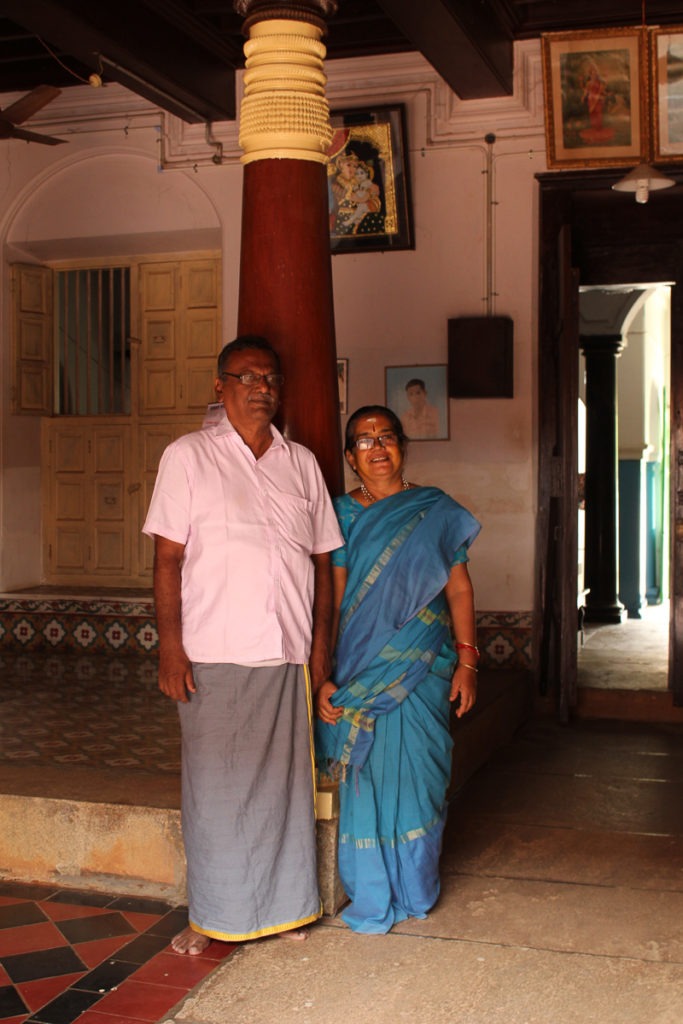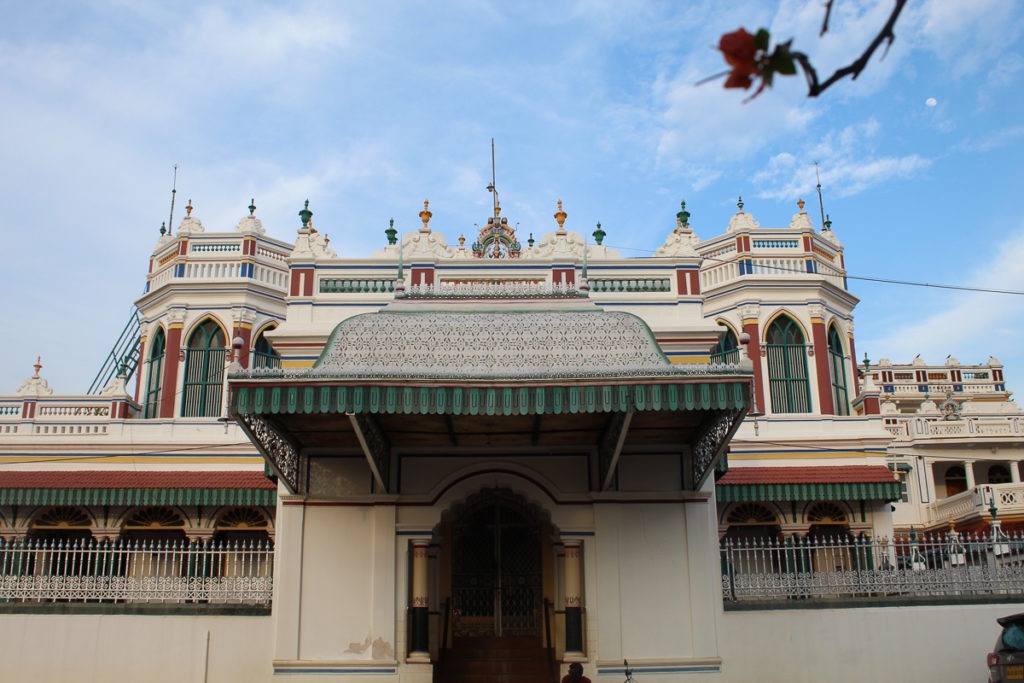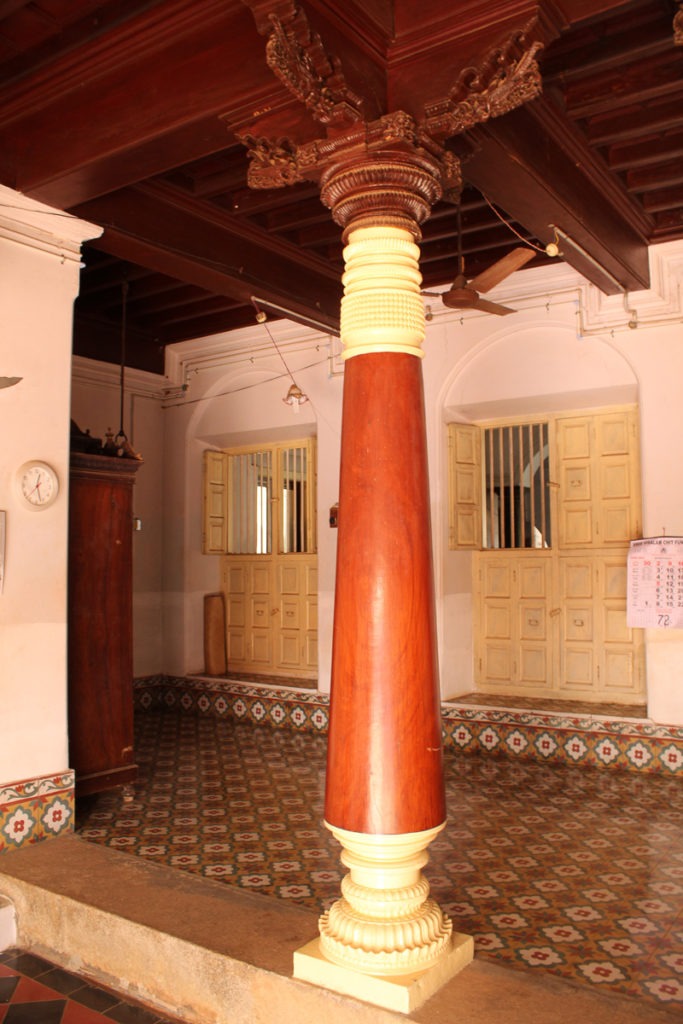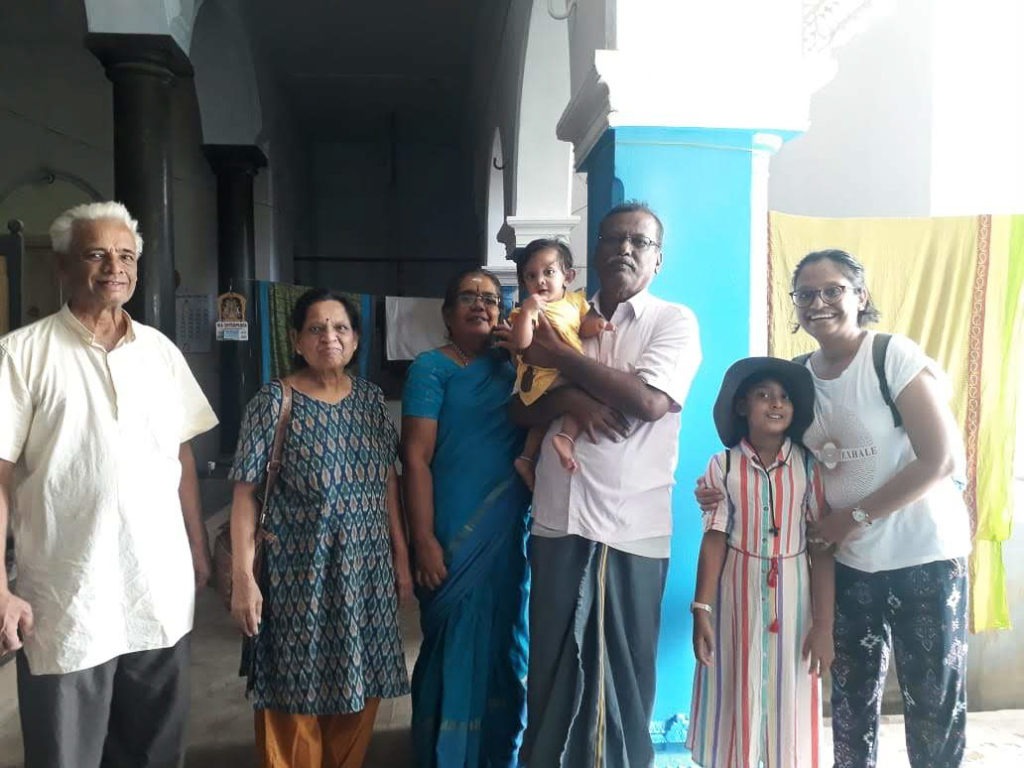“A man’s Self is the sum total of all that he can call his, not only his body and his psychic powers, but his clothes and his house.” William James (The Principles of Psychology, 1890)
Mitraja Bais remembers her discovery of the lost work of Chettinads and the poignant tale of loved objects left in their wake.
I happened to chance on Chettiar material culture in September 2007. It was during my 16 week architecture internship in Auroville, Tamil Nadu. It was also the first time I had stepped 2000 km away from home (Gujarat) to live on my own. We (a group of five architecture interns) were assigned a field visit to Chettinad region to document Attangudi tile making and to track down Master Craftsmen skilled in Chettinad plaster technique, a building craft technique that was steadily depleting due to a steep drop in the number of artisans practicing the craft. I was absolutely oblivious to Chettinad’s existence up until a few days before our visit. Back then, there was no Google search to conduct pre-field investigation, or smartphones to navigate us to a handful of villages whose names I couldn’t even pronounce as I didn’t speak the local language. Communicating with locals was possible only in Tamil and our two Tamil speaking friends doubled up as translators for the rest of us throughout the visit.
The five day field visit yielded good results for us. We visited a few tile making units and documented the process of Attangudi tile making. We were also able to locate two craftsmen working with the Chettinad plaster technique at a restoration site. They were happy to engage in a conversation and informed us that the Master Craftsman they were working with was nearly 70 years old. We were not able to meet him as he was away but the craftsmen explained to us the process of Chettinad plaster technique. The purpose of these crafts was as interesting as their process. However, what struck me the most were the enormous mansions where these crafts were employed and the patrons who enabled them to flourish – Chettinad mansions of Nattukottai Chettiars, a South Indian merchant community from Tamil Nadu. Mansions, constructed in late 19th and early 20th century using imported building materials and furnished with valuable artefacts. Mansions that were a symbol of the community’s rising wealth and power. Mansions that once bustled with nearly a hundred residents on an everyday basis. Mansions that now lay silent in villages that appear to be in a deep slumber, some abandoned, others partially occupied and a handful being restored to their former glory. Mansions that are carefully dismantled so that their contents can fetch a good price in the antique markets. The mansions left a lasting impression on me and filled me with questions about people’s possessions and their inheritance.
If we come to think of William James’ quote, our relationship to the things we own goes far beyond utility and aesthetics. Ownership creates attachment and often our most valued possessions become extensions of the self. These could be a dried leaf collected on a walk in the mountains that now rests between pages of a treasured book; a souvenir carefully chosen on a recent trip abroad; a gift that is now a memory of a cherished occasion as well as of the person who presented it; an heirloom artefact that carries within itself stories of a family’s past; or even a magnanimous ancestral home that once carried some or all of these objects and more. It is almost as if a part of us resides in these objects. However, not all objects can stand the test of time. We may part ways with many valued objects within a lifetime whereas others continue to exist long after we’re gone, and become our legacy. What makes objects valuable enough to be inherited? And what happens when one person’s legacy becomes another person’s encumbrance? How do they choose between holding on and letting go? How does time impact valuable objects that surpass the lifecycle of their owners?
Let’s delve into the story of Nattukottai Chettiars and explore the current state of their material culture, decades after they were passed on as legacies, through the examples of: (i) Chettinad mansions that were built to exhibit the community’s growing wealth and status in the society; (ii) local building craft of Attangudi tiles and Chettinad plaster that were patronised by the community; and (iii) Kazhuththu Uru, a unique wedding necklace of the Chettiars’ that symbolises the union of a man and his wife.
Chettinad and Chettiars
Chettinad is a region located in the Sivaganga district with a small portion extending into the Pudukottai District in Tamil Nadu, India. The region comprises a network of 73 villages and 2 towns forming clusters spread over a territory of 1,550 km2. The region is named after a prosperous merchant community known as Nattukottai Chettiars.
Nattukottai Chettiars, originally, were gem dealers, ship chandlers and salt traders in the 14th century Chola Empire. The community opened the first trading route between India’s west coast and the town of Madurai, in the seventeenth century. By the nineteenth and twentieth century, they earned their reputation as excellent merchants and especially astute bankers. Their collaboration with the British as the official moneylenders of the Empire enabled them to trade with the whole of Southeast. Gradually, they became bankers and pawnbrokers throughout the empire and beyond—Indochina, Mauritius, Cambodia and even in South Africa.
Their vast influence and richness allowed the prospering community to turn the network of villages into opulent clusters of palatial homes. These late nineteenth and early twentieth-century palatial homes are built as per traditional planning and lifestyle principles using local building crafts (Attangudi tiles and Chettinad plaster) and adorned with artefacts such as Burma teak wood, Italian marble, and Belgian chandeliers that were brought back from their expeditions around the world.
The Second World War brutally interrupted this ascent when foreign companies were requisitioned by the British government. Majority of the Chettiar community found themselves practically ruined and hence they returned to Chettinad. Their money lending business witnessed a downfall as an independent India took shape and banks were nationalised. Thus began the downward trend of the businesses and lifestyle of Chettiars. In the following decades, members of the community embraced contemporary professional roles across the globe leaving behind a few thousand deserted mansions in the region of Chettinad.
Evolution of the Chettinad house
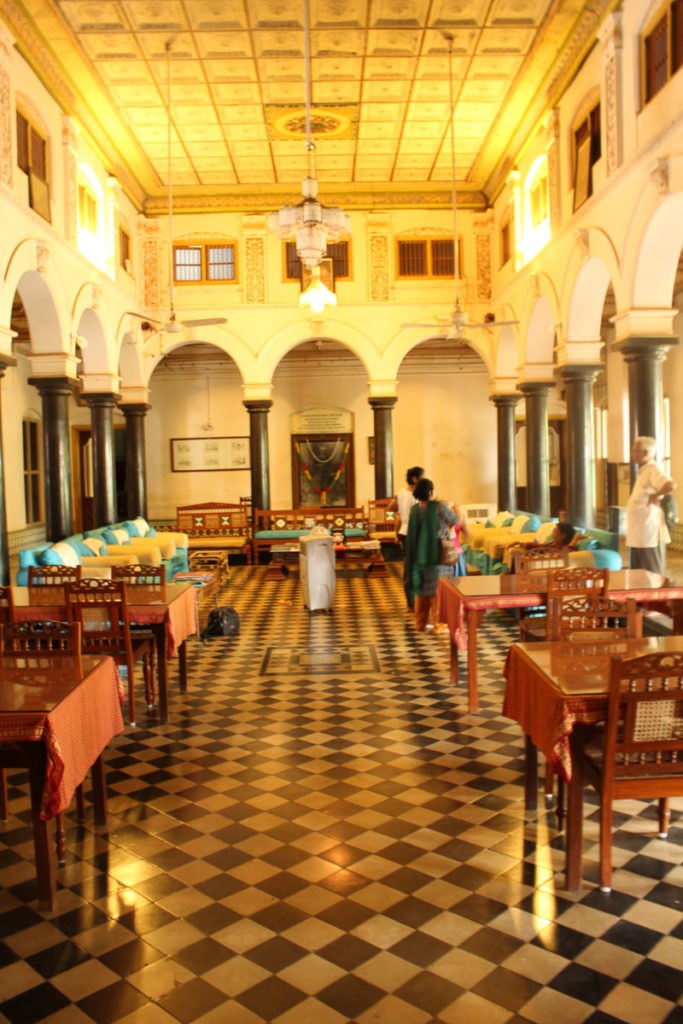
A reception room in a Chettinad mansion that now functions as a boutique hotel. Chettinadu Mansion, Kanadukathan, Tamil nadu
The design of Chettinad mansions evolved from simple traditional single storied houses that follow a simple plan based on traditional building principles with each area serving a specific purpose. A thannai—an external raised platform lined with granite columns—runs along the facade of the house on either side of the main entrance. This space is strictly reserved for men for day to day business. The main entrance opens into a peristyle that provides access to various spaces such as a formal room for receiving guests, women’s resting place, a room for newlyweds (called ‘house’), family altar and storage spaces. The peristyle surrounds an open to sky courtyard known as nadu vasai (inner courtyard) where major family festivities (including weddings) are held. A small passage space connects the peristyle to the backyard. This space, known as mooran kattu, comprises a verandah that houses the kitchen, a stable where cattle are reared for milk, a well and a large open space. Mooran kattu is run by the women of the house and domestic help. Chettinad houses follow a rectangular layout plan that can be accessed from the front as well as back, ensuring uninterrupted business meetings while still allowing the women and domestic help to move in and out freely. The house was built by the local craftspeople using locally available building materials: baked bricks for the main part of the house, terracotta roof tiles, wood and granite pillars. The interior of the walls is polished with a traditional lime plaster technique that reflects light and so is integral in alleviating the ambient heat.
As a result of successful businesses and growing wealth the Chettiars progressively enlarged their houses and developed a distinct style of residence from this simple architectural structure. At the end of the nineteenth and early twentieth centuries, additional alterations successively contributed to transforming the Chettinad house into little palaces. This enabled them to lead a luxurious lifestyle as well as exhibit their power and social success.
The new abodes are striking due to the seemingly oversized scale of the house. Ancillary spaces are introduced to facilitate the growing needs of the expanding families as well as to fulfil the demands of increased social interaction. There is an additional upper level on the main facade that houses guest rooms. A large reception room now lies between the thannai (external raised platform) and the nadu vasai (first inner courtyard) to entertain guests. A pattalai (internal raised platform) built near the nadu vasai is adorned with huge teakwood columns. The space encompassing pattalai and nadu vasai is where all events and festivities take place. The nadu vasai is surrounded by a series of rooms (‘houses’) for each son of the family as he gets married. These rooms also served as storerooms for sumptuous utensils: silverware, copper gifts, etc. offered as dowry by the bride’s family. Sometimes, they also contain safes for protection of jewellery given as wedding presents. Within the community, this room corresponds to a small haven of intimacy, a “house within a house” that remains the exclusive property of the couple for the rest of their lives. Further on, each house contains one or two dining halls. The second inner courtyard, situated on the same axis, is set aside for cooking, eating meals and as the women’s resting place. The roof space of this inner courtyard’s gallery is used as a grain and seed store serving all the household. A backyard, where sometimes there is a second kitchen with fireplaces, is allotted to the servants. A well and stables, where the cows and buffaloes were kept, ensured all the daily supplies of water and milk.
Imported artefacts and local building crafts
Building materials and decorative artefacts that adorn Chettinad mansions elevate their opulence by many folds. The main door is made of wood. Its lintel depicts a figurine of goddess Lakshmi, a symbol of wealth and prosperity, seated on a lotus surrounded by celestial elephants along with various other floral and figural motifs. Burma teak wood, granite and, at places, Italian marble columns enhance the open and semi-open spaces. Belgian lamps/chandeliers embellish wooden ceilings. A dado of Majolica tiles decorates the walls of the thannai (external raised platform) and pattalai (internal raised platform). Floors of public areas are laid with imported Italian marble and locally made Attangudi tiles. Tanjore paintings and Raja Ravi Verma originals along with majestic paintings or photographs of the family’s deceased seniors and/or gods and goddesses adorn the interior walls that are whitewashed with the skilfully laid Chettinad plaster.
Building materials and artefacts were brought back on ships returning home from trade centres across the world. It is said that the Burma teak logs that were too heavy to be carried on the ship were tied to the vessel in such a way that they floated all the way back. Wood thus imported was given ornamental forms by skilled carpenters who borrowed motifs from the temple stone carvings of the region. Columns of Italian marble make an occasional appearance, but floors of marble tiles are a common sight across homes. In earlier times it was difficult to replace the imported marble tiles after wear and tear from ageing as they were not available in the local market, and repairs were expensive due to non-availability of spare tiles. This concern led the people of Attangudi (one of the 73 Chettiar villages) to set up a cottage industry to make replicas of the imported tiles in more vibrant colours and designs. These handcrafted tiles are popular as Attangudi tiles. The process of making these tiles involves a glass base, moulds, white cement, colour pigments, cement and water. A thin layer of pigmented white cement is poured on a glass base through a metal design mould. Soon after, the design mould is removed and dry cement is dusted over the pigments (to prevent them from smudging) followed by a thick layer of wet cement. The tile is then left to dry in the sun before being cured in water for a couple of days and then sun-dried again. Finally, the glass and mould (holding the tile together) are removed and the tile is ready for use. The small scale industry of handcrafted Attangudi tiles may not be able to compete with contemporary tile giants, but the tiles are popular among designers supporting traditional crafts and sustainable building techniques.
Another building craft patronised by the Chettiars is the traditional Chettinad egg-lime plaster or Chettinad plaster. Ordinary lime plaster bears a rough finish on walls or surfaces it is applied on and requires additional coatings periodically. Chettinad plaster, on the other hand, results in a mirror-like polished finish that reflects light and so is integral in alleviating the ambient heat. It is also extremely durable. In some of the Chettinad mansions, the lime plaster has sustained for over a hundred years. The process of preparing and executing the plastering technique is exceptionally tedious. The plaster is a combination of mixed materials and is applied in six layers. The first layer or base coat is a paste made of lime, sand, shell lime (shells are heated and made into powder form) and quartz. This paste is prepared by hand using a traditional mortar and pestle. The base coat is followed by four more layers of the same mixture, the consistency of the mixture needs to be finer than the one before. For the final layer, egg whites and curd water is added to the above mixture (in its finest consistency). In earlier times, craftspeople achieved the mirror-like finish by hand polishing the final layer using merely a coir scrub. There is no documented record of Chettinad plaster technique. Like most ancient craft forms of India, it was taught by Master Craftsmen to their apprentices based on empirical knowledge. Today, not many artisans are willing to practice this technique as it has its shares of risks. Workers get blisters on their hands and feet as lime generates a lot of heat during the mixing process. They have started using protective equipment like gloves and boots but still, they suffer. Chettinad egg plasterwork was identified as a languishing craft by the Craft Council of India in 2019. The proficiency of this craft lies with a handful of Master Craftsmen who, along with various design professionals, are conducting workshops and documentaries to revive this languishing craft.
A token of love
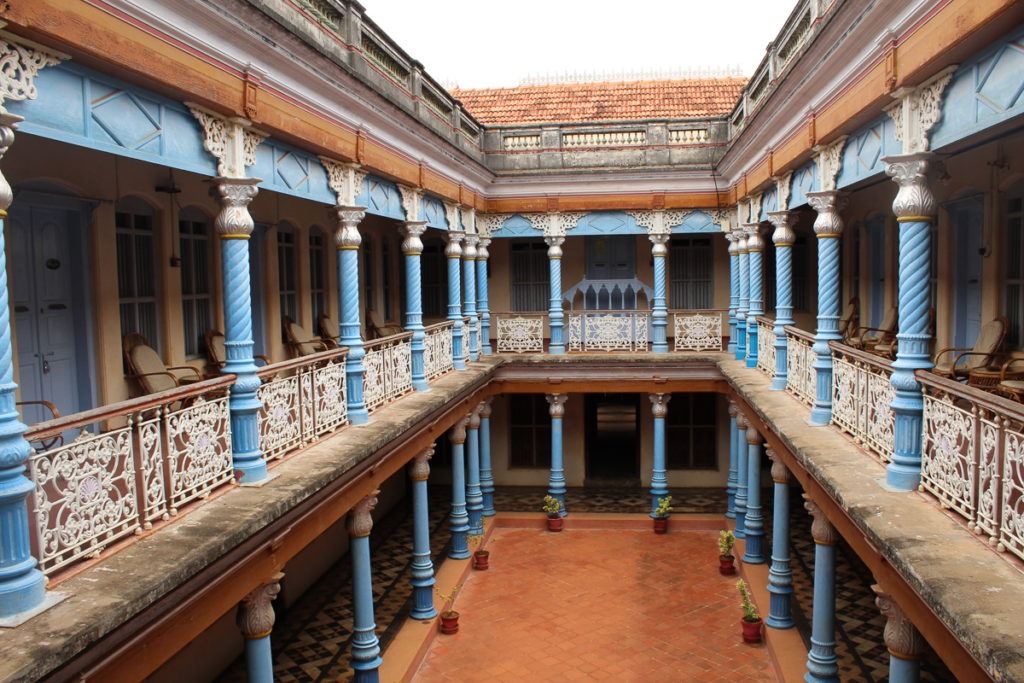
Nadu vasai (first inner courtyard) a focal point for all festive occasions. Chettinadu Mansion, Kanadukathan, Tamil nadu
Despite the architectural and decorative profusion, the main purpose of constructing these mansions was to enable the families to regularly observe their social and religious rituals. Due to the deep attachment that the Chettiars had for their homeland, they periodically returned to Chettinad for household and village celebrations. This provided an opportunity for a reunion of the extended family to discuss decisions concerning the improvement of village activities and to distribute the family resources by the eldest member of the family or the founder of the house. It was common for the community to live in an extended family system. An extended family is similar to a large community integrating grandparents, parents and their descendants, as well as the grandparents’ brothers and sisters with their descendants which can number as many as one hundred people per household. During special occasions, the household comprised of more than three hundred people at a time.
An array of events ranging from household celebrations and receiving guests on occasion of marriages, ceremonies associated with naming a newborn, or veneration of ancestors take place in the space encompassing pattalai (internal raised platform) and nadu vasai (first inner courtyard). Needless to say, their weddings are celebrated in a majestic way. They comprise several traditional rituals that span over a period of three days. In the past, these rituals were distinctly elaborate making weddings a six-day affair. One of the significant customs of the wedding is presenting the bride with Saaman or the gift of household articles. Initially, these were given as gifts for starting a household. However, with the financial success of the Chettiars, the custom of Saaman increasingly became a means of display of wealth and power. A typical collection of Saaman comprises articles of everyday use like vessels, floor mats, and items for the bride’s personal use such as finery and jewellery.

Kazhuththu Uru (Marriage Necklace); Chettinad, South India; 19th century; Gold strung on black thread. Source: www.metmuseum.org.
Of all the jewellery a Chettiar bride receives during the wedding, her most prized possession is the Kazhuththu Uru (pronounced Kala-thiru), a wedding necklace. It is tied by the groom around the bride’s neck after they have exchanged their wedding vows before a sacred fire. The bride’s parents get it crafted by a goldsmith and a portion of the gold for it comes from the groom’s family thus symbolising the union of two families. The pendant (tali) usually forms the central element of the Kazhuththu Uru. It is made of gold and features claw-like pendants strung on a cord with round and tubular beads. The tali is decorated with designs depicting figurines (in the form of Shiva and Parvati), foliage and geometric designs. In Hindu culture, Shiva symbolises consciousness, the masculine principle, whereas Shakti symbolises the feminine principle, the activating power and energy. The union of Shiva and Shakti symbolises life, both universal and individual, as an incessant interaction of co-operating opposites. Besides the wedding day, the ceremonial necklace is also worn during Shashtiabdapurti, a ceremony celebrating the husband’s 60th birthday. According to a Hindu belief, the age of a man is 120 years. Shashtiabdapurti marks half a point of his life and is considered as a milestone among the Nattukottai Chettiars. It is celebrated by performing various religious ceremonies including a reenactment of the couple’s wedding ceremony during which the woman wears the Kazhuththu Uru. A wedding necklace is a very personal possession of a woman. It is valuable in terms of both its symbolic and material sense. I am not certain if it is common for a Kazhuththu Uru to be passed on as heirloom jewellery, but many Kazhuththu Uru have secured a place in museum collections around the world, due to their unique design, craftsmanship and symbolism.
Holding on and letting go
The current state of Chettinad mansions narrates a silent tale of an entire community’s undoing. Families with good business acumen have salvaged their ancestral homes by turning them into heritage hotels. Few others leading a prosperous life away from their homeland employ a large household staff which carries out the daily upkeep of the mansions back home; they regularly pay a visit to their homeland to stay in their ancestral mansions and also continue to observe the household and religious community celebrations. They assume a social role within the villages by funding the construction of new schools and the creation of family temples.
Several families willingly sell their ancestral home and its tastefully accumulated contents to antique dealers who dismantle the homes piece by piece and sell all its elements in the antique markets. By doing so many Chettiar families retrieved some capital that helped them make prosperous post-colonial lives. The antique market of Karaikudi is a major attraction for visitors and collectors alike. There are some shops in Chettinad which sell anything and everything that was once a part of the palatial mansions. These include building elements such as the colossal Burma teak columns, Majolica tiles, Belgian glass, carved doorways, structural members decorated with figurines of yali (a mythical creature part horse, part elephant, part lion); artefacts such as Belgian lamps and Tanjore paintings; as well as everyday objects like furniture (chairs, side tables, swings), Burmese lacquer bowls, spoons and ladles, utensils, mortars and pestles, coffee grinders, tiffin boxes, rotary phones, compasses and telescopes. Having rescued their previous owners from financial downfall, these objects begin a new life in new homes around the world.
Unfortunately, some families have not been able to salvage their ancestral mansions due to disputes arising from multiple ownership leading to abandonment and even demolition of the property without their knowledge. A large number of Chettinad mansions lie deserted as not many families can afford to upkeep their past glory but continue to hold on to them for their emotional value. They sell the majority of artefacts to antique dealers and live out of one or two rooms/areas (for example, then reception hall and pattalai (internal raised platform). They often rent out parts of the mansion for film shoots to help generate some income for maintenance of the house.
People that inhabit the mansions today are usually old. The young ones are spread across the globe working corporate jobs and leading fast-paced modern lives in the cities. Glancing through recent photos I come across a middle-aged couple posing for the camera. The gentleman is dressed in a lungi and shirt, the lady wears a blue saree with a gold border. They are standing in the pattalai against a huge column; the wall behind the column is decorated with a photo of one of their ancestors and a Tanjore painting. Looking at the readily smiling couple, I fondly remember a similar couple I had met back in 2007 and whose names I cannot recall. I shall address them here as Mr and Mrs Kumar. Back then, the Kumar’s were a middle-aged couple who had recently moved in to live in their family’s ancestral mansion. “All our lives we’ve lived across India so we wanted to spend our retired lives in our ancestral home” says Mr Kumar, an ex-Bank Manager. His family had had the mansion for six generations and he intended to pass the family’s legacy on to his sons who had corporate jobs in the city. When asked whether his sons would be interested to come and live here in the future he said “My wife and I chose to spend the rest of our lives in our ancestral home as this place holds an emotional value for me. My sons also visit this place often and we do hope they continue to visit long after we are gone but we would never force them to relocate in this house (against their will), they are free to do as they wish.”
Reflection
All ancestral mansions may not share the same fate but for a majority of the families, they proved to be an asset worth inheriting. While many families struggle to sustain their family homes, a fortunate few who are able to maintain them would be able to carry their family’s legacy and preserve their story for many more decades and let visitors have a taste of the Chettiars’ old world charm. The painstakingly built Chettinad mansions, exquisite building materials and artefacts collected from all over the world, the innovation of Attangudi tiles, use of Chettinad plaster and the Kazhuththu Uru are only a few examples that portray the Chettiar community’s role in endorsing arts and crafts. Other crafts patronised by the community include Kottan (traditional Palmyra basketry of Chettinad), Kandanghi Saree, and Wall stencilling and painting. The community has also left its mark in the food scene and has a cuisine named after them, thanks to extensive travel and social interaction. Chettinad cuisine is possibly the most celebrated fare in the Tamil Nadu repertoire.
A craft is only as strong as its patrons. The crafts of Chettinad flourished under their Chettiar patrons and began to crumble with the downfall of the community. Chettiars took on the role of fine art and craft connoisseurs to showcase their wealth and power, and in the process evolved a unique style that became an extension of their identity; so much so, that the architecture, arts and crafts championed by the community ended up taking on Chettiar identity (Chettinad mansions, Chettinad plaster, Chettinad cuisine). This occurrence indicates the crucial role of a community in sustaining crafts.
Today, many Chettinad houses lie abandoned and the local crafts are on the verge of decline. The point at issue here is not just on the subject of conservation of the ancestral mansions or revival and preservation of traditional craft techniques but also about sustaining a community’s cultural identity. This identity is so personal yet so communal that external stakeholders have come to the community’s rescue. In 2014, the permanent delegation of India submitted an entry to UNESCO to consider Chettinad Village Clusters of the Tamil Merchants as a world heritage site. Several attempts are being made to conserve the legacy of the one thriving merchant community. Organisations like INTACH (Indian National Trust for Art and Cultural Heritage) and the M.Rm.Rm Cultural Foundation are rigorously working towards conservation of Chettinad mansions and preservation and revival of the traditional craft forms through artisan training and community involvement with the hope that many more generations can witness magnificent Chettiar legacy.
Afterword
I look back now from my home in Melbourne. I haven’t been to Chettinad since 2007 and I do not have pictures from that visit anymore. Yet I can vividly recollect the image of streets, the palatial mansions, the antique markets, artisans making Attangudi tiles and craftsmen grinding the shell and lime admixture on a mortar and pestle. My family members in India were kind enough to travel to Chettinad to get some firsthand images for this essay. Looking at their pictures and many others that flood my Google search, I reminisce. A lot has changed in over a decade. Mansions that were being restored during our visit are now fully functioning boutique hotels, retired folks are gladly returning to their ancestral homes, the region is becoming a popular tourist destination, and external stakeholders have stepped in to support the safeguarding of Chettiar legacy. With so much going on the villages seem to be waking from their slumber, one restoration and one homecoming at a time.
Author
 Mitraja Bais is a design researcher with a major in Craft and Technology. She is an independent researcher based in Melbourne, Australia and also works with DICRC, CEPT University, India, as a research associate. Her research interests lie in the field of cultural heritage and disciplines that harness indigenous crafts at their core. She works as a research associate at DICRC, CEPT University. Mitraja is a co-author of Sahaj: Vernacular Furniture of Gujarat, published by CEPT University Press, which is an outcome of the research conducted in Phase I of the Vernacular Furniture of North-West India project. She has previously received the Charles Wallace India Trust and Simon Digby Charitable Trust Scholarship (2016-17) to conduct research on Indian vernacular furniture at the South Asia Collection in Norwich, UK.
Mitraja Bais is a design researcher with a major in Craft and Technology. She is an independent researcher based in Melbourne, Australia and also works with DICRC, CEPT University, India, as a research associate. Her research interests lie in the field of cultural heritage and disciplines that harness indigenous crafts at their core. She works as a research associate at DICRC, CEPT University. Mitraja is a co-author of Sahaj: Vernacular Furniture of Gujarat, published by CEPT University Press, which is an outcome of the research conducted in Phase I of the Vernacular Furniture of North-West India project. She has previously received the Charles Wallace India Trust and Simon Digby Charitable Trust Scholarship (2016-17) to conduct research on Indian vernacular furniture at the South Asia Collection in Norwich, UK.

